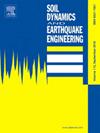The influence of forward-directivity pulse-like ground motion orientation angles on structural collapse capacity
IF 4.2
2区 工程技术
Q1 ENGINEERING, GEOLOGICAL
引用次数: 0
Abstract
Near-fault ground motions typically exhibit significant directivity effects, which significantly influence the structural response and collapse capacity. This study examines forward-directivity pulse-like ground motions, assessing how various orientation angles influence the collapse capacity of structures. To ensure the consistency of ground motion time histories from varying orientation angles during an earthquake, the Directionally Consistent Sac value (DC-Sac) is proposed, based on the Sa (T1,5 %) value indicative of structural collapse (Sac). Building on this metric, the study further explores the collapse capacity of 3-story, 9-story, and 20-story steel frame structures, as well as 3-story RC structures, under ground motion excitations at varying orientation angles. The study reveals that as the angle between the ground motion and the fault strike increases, the destructiveness of the ground motion intensifies, whereas the collapse capacity of the structures decreases linearly.
求助全文
约1分钟内获得全文
求助全文
来源期刊

Soil Dynamics and Earthquake Engineering
工程技术-地球科学综合
CiteScore
7.50
自引率
15.00%
发文量
446
审稿时长
8 months
期刊介绍:
The journal aims to encourage and enhance the role of mechanics and other disciplines as they relate to earthquake engineering by providing opportunities for the publication of the work of applied mathematicians, engineers and other applied scientists involved in solving problems closely related to the field of earthquake engineering and geotechnical earthquake engineering.
Emphasis is placed on new concepts and techniques, but case histories will also be published if they enhance the presentation and understanding of new technical concepts.
 求助内容:
求助内容: 应助结果提醒方式:
应助结果提醒方式:


